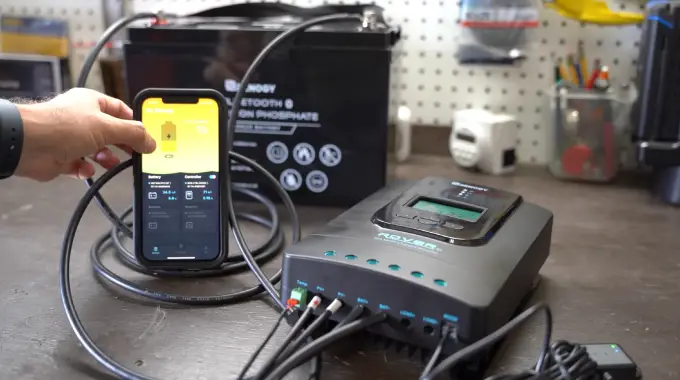Last Updated on May 4, 2023
Are you planning to hit the road in your RV and wondering how long it will take to charge your battery using a 200 watt solar panel? Whether you’re a seasoned RVer or new to the lifestyle, understanding how long it takes for solar panels to charge your RV battery is essential knowledge.
Generally, it takes 5 to 8 hours based on three factors. The intensity of sunlight, the angle and position of the solar panel and the efficiency of the solar charge controller.
Sunlight intensity for charging is affected by sunlight intensity at a particular time, location and day. You can collect more sunlight if your solar panel is at the right angle and positioned right. Solar charge controllers convert stored energy into usable power for RV batteries based on their efficiency.
Here, we’ll dive into how long a 200-watt solar panel will take to charge an RV battery. This will ensure you have enough juice for all your adventures on the open road.
How Long Will a 200 Watt Solar Panel Take to Charge an RV Battery: 3 Factors
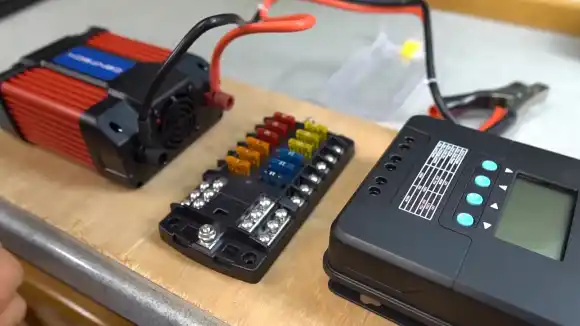
The time it takes to charge an RV battery with a 200 watt solar panel can vary depending on several factors.
No 01: Sunlight Intensity and Duration
Sunlight intensity and duration are critical factors determining the charging time of a 200 watt solar panel for an RV battery. The amount of sunlight the solar panel receives directly impacts the amount of energy generated, affecting the charging time.
The intensity of sunlight is measured in units called irradiance, which is the amount of power per unit area received from the sun. The higher the irradiance, the more energy a solar panel can generate.
Therefore, installing solar panels in an area with maximum sun exposure is essential to ensure maximum energy generation.
The duration of sunlight refers to how long the solar panel receives direct sunlight. Longer exposure to sunlight means more energy generation and faster charging times. But, it is essential to note that not all parts of the day have equal sunlight intensity levels.
For example, early morning and late afternoon have lower irradiance levels than midday when the sun is directly overhead.
And weather conditions such as cloudy skies or rain can significantly reduce sunlight intensity and duration, leading to slower charging times. It is crucial to consider these external factors when calculating estimated charging times for an RV battery using a 200 watt solar panel.
No 02: Angle and Position of the Solar Panel
The angle and position of a solar panel are crucial factors that affect its charging efficiency. The optimal angle and position of the panel depending on the location, time of year, and time of day.
Ideally, the solar panel should face the sun directly to receive maximum sunlight. This means that it should be positioned perpendicular to the sun’s rays. In addition, the angle of inclination should be adjusted according to the latitude of your location.
For example, in a region with a high latitude, such as Alaska or Canada, during winter, you will need to tilt your panels at a steeper angle to capture more sunlight.
Another critical factor is shading. Any object that casts a shadow over the panel will reduce its efficiency by blocking out sunlight. Therefore, installing solar panels in an area free from obstructions such as trees or buildings that can cast shadows over them is essential.
Also, it is recommended to install adjustable mounts for your solar panels to adjust their angle throughout the day as the sun moves across the sky. This will ensure maximum exposure to sunlight and improve charging efficiency.
No 03: Efficiency of the Solar Charge Controller
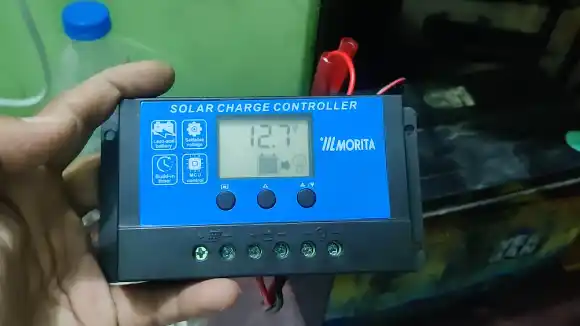
The efficiency of the solar charge controller is a crucial factor to consider when charging RV batteries with a 200 watt solar panel. The solar charge controller regulates the amount of electricity that flows from the solar panel to the battery, preventing overcharging and extending the battery’s lifespan.
Charging controllers come in two types: PWM (Pulse Width Modulation) controllers are less expensive but less efficient, while MPPT controllers are more expensive. MPPT (Maximum Power Point Tracking) controllers can convert excess voltage into additional amperage, increasing charging efficiency by up to 30%.
Choose a solar charge controller for your RV battery that is compatible with your panel and battery. The controller should have a capacity rating that matches or exceeds the maximum output of your panel. Also, it should be able to handle your battery’s voltage and amperage requirements.
You may also consider using a smart charge controller to optimize charging efficiency. These controllers use advanced algorithms to adjust charging rates based on factors such as temperature and battery condition, maximizing charging speed while minimizing wear and tear on the battery.
How to Calculate Charging Time for a 200 Watt Solar Panel?
To calculate the charging time for a 200 watt solar panel, there are a few important factors to consider.
The first step is determining amp-hours battery capacity (Ah). This will give you an idea of how much energy your battery can store and how long it will take to charge.
Next, you’ll need to calculate the charge rate of the battery. This will depend on the type of battery you have and its current state of charge. For example, if you have a 100 Ah battery currently at 50% capacity, it must be charged with 50 Ah of energy.
It’s also important to consider your battery and charge controller’s efficiency. A high-quality controller can improve charging efficiency and reduce overall charging time.
Once you have determined these factors, you can move on to calculating the daily energy requirement of your RV. This will vary depending on your usage habits and appliances, but knowing how much energy you’ll need each day is essential.
RV Batteries and Solar Panels: Tips for Optimum Charging Time
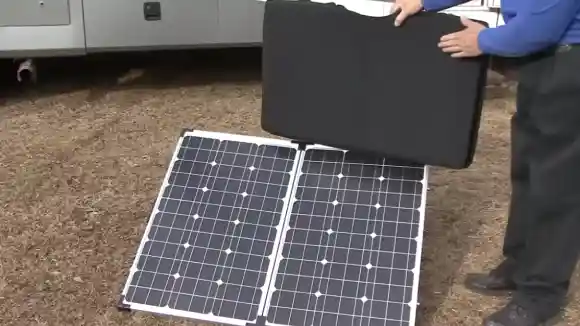
Using solar panels to charge RV batteries is an excellent way to keep your power source running without relying on traditional electricity. It’s essential to optimize the charging time for maximum efficiency. Here are some tips that can help you do just that.
Use High-Quality, Efficient Components
One of the most important factors in optimizing charging time for RV batteries with solar panels is using high-quality, efficient components. This includes not only the solar panel itself but also the battery and charge controller.
Investing in top-of-the-line equipment may cost more upfront, but it can save you money in the long run by reducing charging time and extending the life of your battery.
Keep Panels Clean and Free from Debris
Another critical factor in optimizing charging time is keeping your panels clean and debris-free. Dirt, dust, and other particles can block sunlight from reaching your panels, reducing their efficiency. Regularly cleaning your panels with a soft brush or cloth can help prevent buildup and ensure maximum sun exposure.
Install Panels in an Area with Maximum Sun Exposure
The location of your solar panels also plays a significant role in how quickly they can charge your RV battery. Install them in an area with maximum sun exposure throughout the day for the best results. Avoid placing them near trees or other structures that could cast shadows on them during peak sunlight hours.
Monitor Battery Charge Levels Regularly
Finally, monitoring your battery charge levels regularly is essential to ensure that they’re not getting too low or too high. Overcharging or undercharging can damage your battery over time and reduce its lifespan. A monitoring system or app can help you keep track of your battery’s charge levels and adjust accordingly.
What type of RV Battery can be Charged with a 200 Watt Solar Panel?
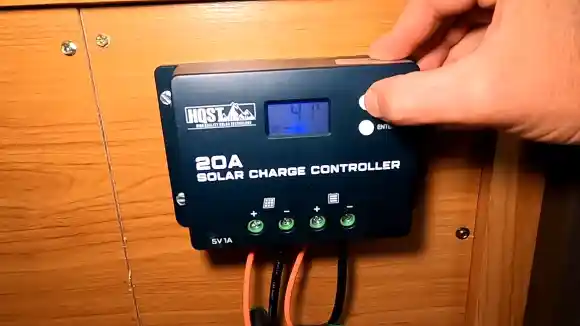
A 200 watt solar panel can charge different types of RV batteries, including lead-acid batteries, lithium-ion batteries, and gel batteries. Each type of battery has distinct characteristics and charging requirements.
Lead-acid batteries are the most commonly used RV batteries and are comparatively affordable. Lithium-ion batteries are more expensive but offer higher performance, longer lifespan, and faster charging time.
Gel batteries are also available as an alternative to lead-acid batteries, and they are a maintenance-free option that is more durable and vibration-resistant. Thus, depending on your needs and budget, you can choose the type of battery that suits you best.
Can a 200 watt solar panel charge multiple RV batteries at once?
It is possible to charge multiple RV batteries simultaneously using a 200 watt solar panel. The batteries must be connected in parallel to the solar panel to ensure efficient and even charging.
Charging batteries in parallel means the positive terminals are connected, and the negative terminals are connected before connecting to the solar panel. With this setup, the solar panel will distribute the charge equally between each battery, ensuring optimal charging performance.
What happens if a 200 watt solar panel is not powerful enough to charge an RV battery fully?
Using a 200 watt solar panel can reduce RV battery life and performance if it’s not powerful enough. It is essential to ensure that you choose a solar panel that matches the energy requirements of your RV and upgrade to a higher-capacity panel if necessary.
One way to supplement the solar panel is by using a battery charger or a generator. A battery charger can help recharge your RV battery if the solar panel is not getting enough sunlight.
Meanwhile, a generator can be an alternative power source for your RV, especially during cloudy days or when the battery is running low. So, ensuring a sufficient power supply is essential for maintaining optimal performance and extending the lifespan of your RV battery.
Unlock the Power of Solar Energy to Charge Your RV Battery
The charging time for a 200 watt solar panel to charge an RV battery depends on several factors such as sunlight intensity and duration, angle and position of the solar panel, and efficiency of the solar charge controller.
Charge time is calculated by calculating the battery capacity in amp-hours, the battery’s charging rate, the battery’s and charge controller’s efficiency, and the RV’s daily energy use.
If you want to maximize RV batteries’ charging time with solar panels, use high-quality and efficient components, keep panels clean and free from debris, place them where they get the most sun, and monitor battery charge levels regularly.
By following these tips, you can ensure that your RV’s battery is always charged enough to power all your appliances during your travels.

